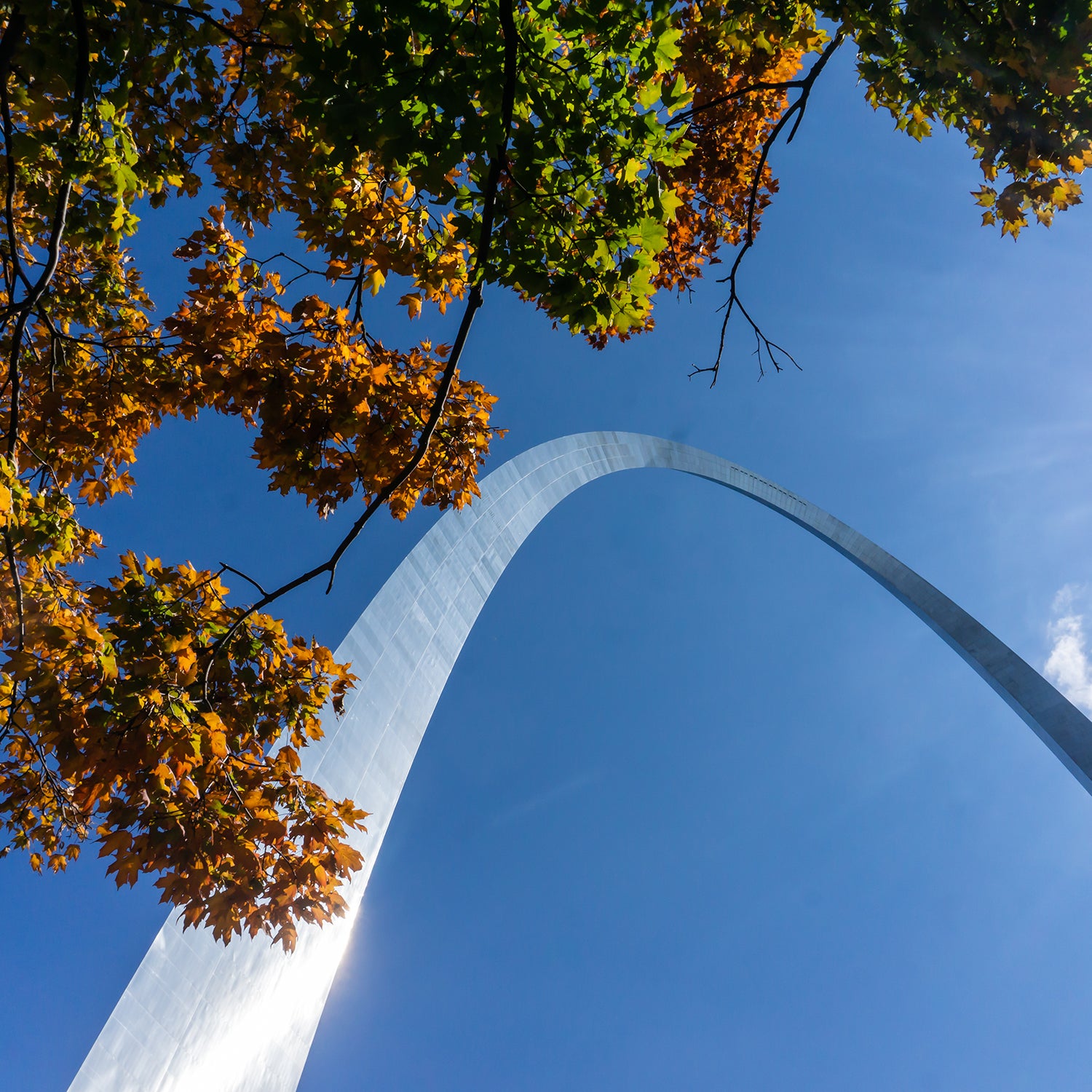63 Parks Traveler started with a simple goal: to visit every U.S. national park. Avid backpacker and public-lands nerd saved up, built out a tiny van to travel and live in, and hit the road, practicing COVID-19 best safety protocols along the way. The parks as we know them are rapidly changing, and she wanted to see them before it’s too late. Gateway Arch is her 46th park visit.
After a whirlwind of mountainous parks in Alaska, Washington, and California, I arrived in downtown St. Louis, Missouri and parked my van at a meter underneath the highway, confused. By that point, I had become accustomed to national parks as places of refuge from cities, not manicured lawns and manmade lakes within them. In my mind, a national park was defined as a wild expanse set aside to protect natural wonders, cultural resources, and wildlife. I wondered; how had one been established at the center of such urban sprawl?
The 630-foot is a marvel of modern engineering, by any standards. Completed in 1965 and designed by Finnish-American architect Eero Saarinen, the arch towers over the St. Louis skyline. Its height and scale are symbolic of manifest destiny, its futuristic chrome a nod to the space race of the time.
The arch sits on the banks of the Mississippi River and is meant to mark a location near where Meriwether Lewis and William Clark began and ended their (1804 to 1806) of the land acquired in the Louisiana Purchase, bought by President Thomas Jefferson just one year prior.
Visitors to the park can meander the grounds on the paved, 1.6-mile Gateway Arch Trail, which curves around colorful honey locust trees and manmade lakes, offering tremendous views of the arch itself. There’s also a developed riverfront area, complete with guided riverboat tours, a historic Old Courthouse where the Dred Scott Case was decided, and a recently remodeled underground museum which details the complicated history of westward expansion.
Walking around the park on a hot October afternoon, I found myself appreciating the recent efforts taken to acknowledge how much land had been stolen from Native American tribes as a result of Lewis and Clark’s expedition. The park underwent a five-year, $380 million renovation before reopening in 2018, which includes the addition of with an entire section dedicated to Native land history. But there was also a pang in the pit of my stomach. A befuddled feeling that this didn’t feel much like a national park at all.
As one of our newest national parks, the bill to redesignate the Jefferson National Expansion Memorial into Gateway Arch National Park was sponsored in 2017 by, the state’s senior republican senator. But, even in its nascent form, the park struck controversy. Not one month after the bill was proposed, Robert Vogel, acting deputy director of the National Park Service, suggesting that the park would better fit the department’s definition of a national monument. He cited that “national parks contain a variety of resources and encompass large land or water areas to help provide adequate protection of the resources.” At a scant 91 acres, Gateway Arch did not fit the bill.
Before the park’s massive reconfiguration, it was a drive-up tourist attraction in the heart of one of America’s biggest cities. Visitors would hop out of their cars, snap a photo, and leave. The economic advantages of having them stay at least a half day were a tremendous opportunity for the state, one that Curbed likened to a. Surely more money would flow in if they could get a national park designation, too.
President Trump signed the bill into law on February 22, 2018.
I made my way under the arch and onto a sidewalk bordering the Mississippi River, fabled artery of trade for so many centuries. Street performers and horses were panting in the sweltering sunshine while riverboat barkers tried to drum up some business.
“There’s surely a lot of history here,” I thought to myself. “Just don’t call it a national park.”
63 Parks Traveler Gateway Arch Info
Size: 91 acres
Location: Eastern Missouri
Created in: 1935 (Jefferson National Expansion Memorial), 2018 (National Park)
Best For: Cultural history, short walks, river tours, city views
When to Go: Gateway Arch is a great year-round destination, due to much of the attractions being indoors. Spring (38 to 77 degrees), summer (67 to 90 degrees) and fall (39 to 81 degrees) have the most palatable temperatures.
Mini �����ԹϺ���: After exploring the museum, take the (from $12) of Gateway Arch and gaze out at spectacular views of the St. Louis skyline, the Old Courthouse, and the infamous Mississippi River.
Mega �����ԹϺ���: Go on a (from $21) on a replica 19th-century paddle-wheel riverboat. The park has a variety of brunch, dinner, sightseeing, and specialty tours available for booking, letting park-hoppers tailor-make their visit with the perfect Mississippi River outing.
��


